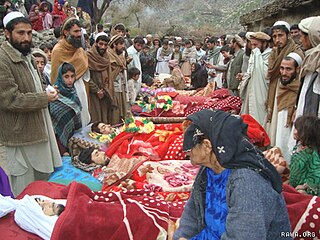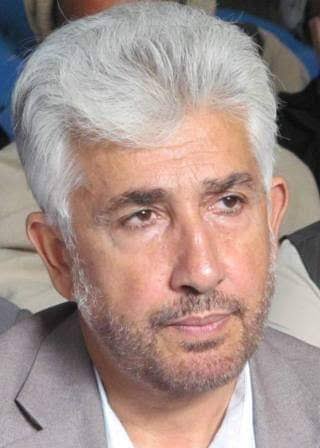
Mullah Abdul Salam Zaeef is an Afghan diplomat who was the Afghan ambassador to Pakistan before the US invasion of Afghanistan.
Wakil Ahmad Muttawakil Abdul Ghaffar is an Afghan politician who has been a member of the militant Taliban organization. He was the Taliban foreign minister from 27 October 1999 in their first Islamic Emirate of Afghanistan rule, until the Taliban were deposed in late 2001. Prior to this, he served as spokesman and secretary to Mullah Mohammed Omar, leader of the Taliban. After the Northern Alliance, accompanied by U.S. and British forces, ousted the regime, Muttawakil surrendered in Kandahar to government troops.

Mullah Mohammad Fazl is a member of the Taliban militant group and the First Deputy Defense Minister of the Islamic Emirate of Afghanistan, having assumed the role on 7 September 2021. He also served in the position during the previous Taliban government (1996–2001).
During the War in Afghanistan, according to the Costs of War Project the war killed 176,000 people in Afghanistan: 46,319 civilians, 69,095 military and police and at least 52,893 opposition fighters. However, the death toll is possibly higher due to unaccounted deaths by "disease, loss of access to food, water, infrastructure, and/or other indirect consequences of the war." According to the Uppsala Conflict Data Program, the conflict killed 212,191 people. The Cost of War project estimated in 2015 that the number who have died through indirect causes related to the war may be as high as 360,000 additional people based on a ratio of indirect to direct deaths in contemporary conflicts.

Abdul Haq Wasiq is the Director of Intelligence of the Islamic Emirate of Afghanistan since September 7, 2021. He was previously the Deputy Minister of Intelligence in the former Taliban government (1996–2001). He was held in extrajudicial detention in the Guantanamo Bay detainment camps, in Cuba, from 2002 to 2014. His Guantanamo Internment Serial Number was 4. American intelligence analysts estimate that he was born in 1971 in Ghazni Province, Afghanistan.

Sabar Lal Melma was a citizen of Afghanistan who was held in extrajudicial detention in the United States Guantanamo Bay detainment camps, in Cuba. Sabar Lal Melma's Guantanamo Internment Serial Number was 801. American intelligence analysts estimate that Sabar Lal Melma was born in 1962, at Darya-e-Pech, Afghanistan.
Events from the year 2007 in Afghanistan.
Events from the year 2009 in Afghanistan
Events from the year 2010 in Afghanistan.

The night raid onNarang was a night raid on a household in the village of Ghazi Khan in the early morning hours of December 27, 2009. The operation was authorized by NATO and resulted in the death of ten Afghan civilians, most of whom were students, and some of whom were children. The status of the deceased was initially in dispute with NATO officials claiming the dead were Taliban members found with weapons and bomb making materials, while some Afghan government officials and local tribal authorities asserted they were civilians.
The Wech Baghtu wedding party airstrike refers to the killing of about 37 Afghan civilians, mostly women and children, and injuring about 27 others by a United States military airstrike on 3 November 2008. The group was celebrating a wedding at a housing complex in the village of Wech Baghtu, a Taliban stronghold in the Shah Wali Kot District of Kandahar province, Afghanistan.
Events from the year 2011 in Afghanistan.
The Afghanistan High Peace Council (HPC) was a body of the Afghanistan Peace and Reintegration Program, established by Hamid Karzai to negotiate with elements of the Taliban. The HPC was established on 5 September 2010. The last chairman of the council was former Afghan Vice-President Karim Khalili who was appointed to the post in June 2017.The council was initially chaired by former President of Afghanistan Burhanuddin Rabbani until his assassination in 2011.

Mullah Noorullah Noori is a militant and Minister of Borders and Tribal Affairs of the Islamic Emirate of Afghanistan since 7 September 2021. He was also the Taliban's Governor of Balkh Province during their first rule (1996–2001). Noori spent more than 12 years in the United States's Guantanamo Bay detention camps, in Cuba. Noori was released from the detention camp on May 31, 2014, in a prisoner exchange that involved Bowe Bergdahl and the Taliban Five, and flown to Qatar.
The Afghan Threat Finance Cell was a multi-agency intelligence organization in Afghanistan. The organization was created in 2008. The United States' Drug Enforcement Administration was the lead agency in the organization. The co-deputy agencies were the United States Treasury and the United States Department of Defense. Other participating agencies included the Royal Canadian Mounted Police, the United States Federal Bureau of Investigation, the United States Department of Homeland Security, and the United States Internal Revenue Service.
Haji Yar Mohammed was a second cousin of Afghan President Hamid Karzai who was killed during a night raid by United States special forces on March 10, 2011. He is from Karz, the same village as the President.

Ahmad Waheed Mozhdah was a senior Afghan political analyst, writer and a peace activist. He was also a poet and wrote several anti-Soviet poetry during the Soviet Afghan war. He was widely cited by various international newspapers for his views on Afghan conflict. During his career, Muzhda criticized both the Taliban and the Afghan government. Muzhda was praised as a probing intellectual by many journalists and scholars. He was assassinated on 20 November 2019 in Kabul. Several political observers and experts believe that Muzhda was assassinated for his views by pro-government groups as 'a part of campaign to silence people with different views'. Previously, he was reported to have been arrested by Afghan intelligence agency NDS.
The Joint Prioritized Effects List or JPEL was a list of individuals who coalition forces in Afghanistan tried to capture or kill. The Task Force 373 was working through the list. According to the Afghan War Diary German troops listed Shirin Agha with the number 3145 and on 11 October 2010 German troops killed Agha. Coalition forces were authorized to kill or capture individuals named on the list.







